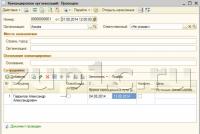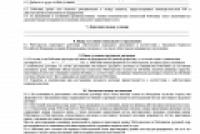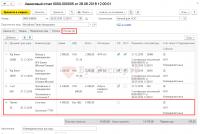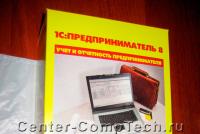Why is not written off in 1s. Write-off of fixed assets. How to register and commission an OS
I propose to consider in this article a detailed example of accepting fixed assets for accounting in 1C 8.3 in the form of step-by-step instructions. The accounting procedure for such assets is determined by PBU 6/01 "Accounting for fixed assets".
When buying a fixed asset, an accounting entry is generated 08.04 – 60.01 (in detail -). It follows from this that the equipment is simply listed “in the warehouse” on account 08.04 “Acquisition of Fixed Assets” and is not used, and depreciation is not charged on it.
In order for the purchased equipment (machine, car, computer, etc.) to begin to be listed as a fixed asset in the organization and begin to depreciate, it is necessary to correctly take it into account.
Let's figure out what it means to take into account in 1C 8.3. From an accounting point of view, this means that it needs to be moved from 08.04 accounts to account 01.01 "Fixed assets in the organization". The program also needs parameters for calculating depreciation both in accounting and in.
For all this, there is a document "Acceptance of fixed assets". Let's consider it in more detail.
Creation and filling of the document "Acceptance of fixed assets"
To create a new document, go to the menu "OS and", then click on the link "Acceptance for accounting of OS". A window with a list of documents will open. In this window, click the "Create" button. A window for creating a new document will appear:
In the header of the document, we indicate the organization, department (location of the OS), the financially responsible person and the OS event.
Get 267 1C video tutorials for free:
Let's move on to the first tab “Non-current asset”. We select the equipment that we want to take into account. We will also indicate the warehouse where it is stored.
On the tab "Fixed assets" we collect the list of fixed assets to be accepted for accounting. In our case, this will be one line that corresponds to the hardware:

In addition to selecting a fixed asset, you need to assign an inventory number on this tab page. By default, this number is automatically substituted from the "Fixed Assets" reference book ("References" menu, hereinafter the "Fixed Assets" link).
Briefly about this guide: it stores all the parameters of the fixed asset and is changed by documents during operation.
For example, we can change the inventory number in our created document, which was taken from the directory. After the document is posted in the directory, this number will also change. Entries in such a directory are also called fixed asset cards.
Setting up the parameters of depreciation of fixed assets in 1C 3.0
In this article, devoted to accounting in government agencies, I would like to consider such a seemingly simple at first glance issue - this is the purchase and acceptance of fixed assets in the 1C program: Accounting of a public institution 8 rev.1.0. But as in any operation, there are also several important nuances that must be taken into account when working.
So, in order to "capitalize" a fixed asset in the program, you need to draw up several documents. The first document with which we start is "Purchase of fixed assets, NFA" (section "Fixed assets" - Receipt of fixed assets, NFA - Purchase of fixed assets, NFA).
Suppose we are buying a table with subsidies for a government assignment worth 50,000 rubles. Create a new document and start filling it out.

Go to the "Capital investments" tab, add a new line and to create an NFA object, go to the "Fixed assets" directory.

Fill in the fields "Name" and "Full name", be sure to select "Capital investments" in the "Type of NFA" field. You don't need to fill out anything else. It is also very important to set up the correct hierarchy in the fixed assets catalog.

For the document "Purchase of fixed assets" we create an item in the folder "Capital investments", and for the document "Acceptance of fixed assets" - in the folder "Fixed assets", in which you can already create your own hierarchy, as you like.
After choosing a position from the directory, we fill in everything further along the line.

We save and post this document.
In order to accept this fixed asset for accounting, you need to enter the document "Acceptance of fixed assets and intangible assets". It is convenient to create it immediately from the document "Purchase of fixed assets, intangible assets".

When you click on the "Accept for accounting" button, processing of document formation opens. Click "Generate".

A document "Acceptance of fixed assets and intangible assets" is created, in which part of the data on the "General" tab is automatically filled in from the purchase document.

And proceed to filling out this document: on the "Fixed Assets" tab, add a new line and now select a position from the "Fixed Assets" folder with the NFA "Fixed Assets" type.

Go to the "Depreciation" tab.

Here I would like to draw your attention to the issue of choosing the OKOF code from the corresponding reference book. At first glance, this is a trifle, but it can cause a lot of inconvenience to people who do not know how to use this guide.
OKOF is an all-Russian classifier of fixed assets. It is used for the correct calculation of depreciation: selection of depreciation group, useful life.
The OKOF code is not always indicated in the documents for the receipt of fixed assets, and we have to determine it ourselves. How to quickly do this?
The directory is hierarchical, initially it looks like this:

The first thing we do is uncheck the hierarchical view so that all folders open:

Consider a situation where we do not have a code, but only the name of the main asset. We need to search by name, for this we click on the line where “Name” is written, and the selection icon goes to this column.

After that, we start typing the name and select the desired position from the list.

If we have a code, then we rearrange the icon in the “Code” column and search by code.
We return to filling out the document “Acceptance of fixed assets and intangible assets for accounting”. It is very important at this stage not to forget to note that commissioning is carried out simultaneously with accounting, otherwise depreciation will not be charged on this fixed asset.
We fill in the necessary data and after that we write down the document, conduct it. Now the fixed asset is taken into account.
If you need more information about working in 1C: BSU 8, then you can get our collection of articles on.

Consultant Maple company for 1C programs for government agencies
Vladimir Ilyukov
Acceptance for accounting and commissioning of fixed assets (OS) is a fairly common task for accountants. With the release of version 3.0.45, we can talk about the presence in 1C Accounting 8 of two ways to put the OS into operation: normal (three-stage or two-stage) and simplified (one-stage). In the usual way, at least two documents (registrars) and two reference books must be drawn up. In simplified form, it is enough to issue one registrar. In the working base of the user, he will simultaneously reflect the receipt, commissioning and fill out the directory "Fixed assets".
![]() Today, March 15, 2017, I am publishing this article and suddenly I find that 1C is ahead of me. What a shame! Just two days ago, on March 13, 2017, its author published an article on the same topic. Here is the link http://buh.ru/articles/documents/54524/. Read it, it is quite possible that you will find there what I missed to say or said not very clearly. If, that at the end of the article, in the reviews, you can leave your comment or question.
Today, March 15, 2017, I am publishing this article and suddenly I find that 1C is ahead of me. What a shame! Just two days ago, on March 13, 2017, its author published an article on the same topic. Here is the link http://buh.ru/articles/documents/54524/. Read it, it is quite possible that you will find there what I missed to say or said not very clearly. If, that at the end of the article, in the reviews, you can leave your comment or question.
The simplified method is useful for any organization that from time to time acquire non-current assets. It will be especially in demand among small businesses, individual entrepreneurs, lawyers and notaries.
To focus on the features of the simplified method, we recall that the simple method of taking into account consists of three or two consecutive stages, steps.
First... At this step, the asset is registered in accounting (BU). It is registered by the same registrar, to which two links are provided in the configuration: “ Purchases\u003e Purchases\u003e Receipt (acts, invoices)\u003e type of operation Equipment"And" Fixed assets and intangible assets\u003e Receipt of fixed assets\u003e Receipt of equipment". In the process, a posting is created in the debit of the subaccount 08.04.1 "Purchase of fixed assets components". We will talk about it a little later.
Second... Formation of the initial (accounting) value of the purchased OS. In tax accounting (NU, art. 257 Tax Code) and in accounting (BU, PBU 6/01) Algorithms for evaluating non-current assets are somewhat different. The general thing is that the book value consists of the costs of acquiring a non-current asset, its construction, delivery and bringing to a state in which it can be used for its intended purpose. The type of registrars used is determined by the cost element.
Third... After all the preparatory actions with the non-current asset are completed, and it is ready for use as intended, this event is reflected in the information base by the registrar " Fixed assets and intangible assets\u003e Receipt of fixed assets\u003e Acceptance of fixed assets for accounting". In the process, it forms a posting from the credit of the subaccount 08.04.1 "Purchase of components of fixed assets" to the debit of the subaccount 01.01 "Fixed assets in the organization".
The second step may be absent and the three-step method turns into a two-step one: it is a little simpler, but not very much. The fact is that at the first step, you still have to describe the non-current asset in the Nomenclature directory as equipment. This is due to the fact that it is attached as a sub-account on subaccount 08.04.1 "Purchase of fixed assets components". It should also be noted that before performing the third step, the non-current asset also needs to be described, but already in the fixed assets directory.
For many years, many of us have got used to the three-stage scheme for commissioning non-current assets in 1C. However, with the advent of a one-stage method, the process of accepting OS for accounting in 1C 8.3 has become significantly simplified.
Simplified acceptance of OS for accounting in 1C 8.3
A simplified, one-stage commissioning combines the registration procedure (posting to debit subaccount 08.04) and subsequent commissioning. The latter is reflected by an entry in the debit of the subaccount 01.01.
The one-step method is easier and more convenient. At the same time, it does not override the simple, three-step (two-step) method. The one-step method is reduced to the design of one document, to which there are two links: “ Fixed assets and intangible assets\u003e Receipt of fixed assets"And" Purchases\u003e Purchases\u003e Receipt (acts, invoices)\u003e transaction type Fixed assets».

To implement a one-stage scheme, the developers of 1C company attached internal sub-accounts to account 08.04 "Acquisition of fixed assets":
- subaccount 08.04.1 "Purchase of components of fixed assets". It is used in the usual OS acceptance scheme. Analytics is carried out in the context of the elements of the "Nomenclature" directory.
- subaccount 08.04.2 "Purchase of fixed assets". It is used in a simplified scheme for accepting OS for accounting. Analytics is carried out in the context of the elements of the fixed assets directory.

Account 08.04 "Purchase of fixed assets" became a group account and therefore cannot be used in postings. Instead, subaccount 08.04.1 "Purchase of fixed assets components" is now used in the usual scheme.
In the register "Receipt (acts, invoices)", the list of types of operations, the developers have replenished with one more, this is "Fixed assets". It should be selected when using the one-step method.
In the one-stage method, the book value of a non-current asset is not formed from additional costs. It is assumed that they are not. Therefore, it is simply set equal to the price paid to the supplier, but with the following caveat. Payers of value added tax accept input VAT for deduction. On the contrary, non-payers of VAT (for example, the simplified tax system) include the input VAT in the book value.
Consider an example in which one server is counted in both the BU and OU, and the other is counted only in the BU.
 The organization LLC "Accounting OS" bought the Team Server R3-E52 server for 177,000 rubles, incl. VAT 27,000 rubles and Team Server R2-E52 for 82,600, incl. VAT 12,600 rubles. They must be taken into account as an OS. There are no additional costs. The initial cost is equal to the cost of purchasing them from the supplier.
The organization LLC "Accounting OS" bought the Team Server R3-E52 server for 177,000 rubles, incl. VAT 27,000 rubles and Team Server R2-E52 for 82,600, incl. VAT 12,600 rubles. They must be taken into account as an OS. There are no additional costs. The initial cost is equal to the cost of purchasing them from the supplier.
We will assume that the prepayment has already been made. We are opening a new registrar " Shopping\u003e Shopping\u003e Receipt (acts, invoices)". In the form that opens, click on the "Receipt" button and select the "Fixed assets" operation.

In the column "Fixed asset" with our hands from the keyboard we drive in the name of our server. The registrar will instantly discover that there is no such server in the infobase and will immediately offer to create it. We agree with this proposal.
As a result, without opening the "Fixed assets" catalog, a new item will be created in it. Data in the card details are automatically transferred from the registrar when it is saved. During the posting process, it creates the following transactions.

We note that subaccount 08.04.2 "Acquisition of fixed assets" is used in transit. First, both servers are accounted for under the debit of the subaccount 08.04.2 "Purchase of fixed assets". Then the same document forms a posting to the debit of the subaccount 01.01 "Fixed assets in the organization".
Let's comment on lines No. 3-4. Record on line no. 3 registers in the infobase the event of commissioning the Team R2-E52 server. Moreover, this record is reflected in both the BU and OU. Then, by record No. 4, the Team R2-E52 server is removed from OU. Ultimately, it is only counted in the BU.
The reason for this behavior is quite understandable. The estimated cost of the Team R2-E52 server did not exceed 100,000 rubles. Therefore, it does not apply to depreciable property, with clause 1 of Art. 256 of the RF Tax Code... If so, then in NU the cost of the Team R2-E52 server cannot be charged to income tax expenses by writing off monthly or seasonally accrued depreciation. Nevertheless, it is possible to recognize them in expenses, but in a different way. They can be taken into account as part of material costs, and in full amount at the time of registration of a non-current asset in operation, sub. 3 p. 1 art. 254 Tax Code.
It was this legal norm that was reflected in the document. This is easy to see if you open the Team Server R2-E52 card on the NU Information tab.

It can be seen that the cost of the Team Server R2-E52 is included in the material costs at the date of its commissioning. We emphasize: it is turned on automatically.
The registration of the Team R3-E52 server took place quite differently. The entry in line No. 6 registered the fact of acceptance for accounting of fixed assets with a book value of 150,000 rubles both in the BU and in the NU. At the same time, the document takes into account that Team Server R3-E52 belongs to depreciable property. Consequently, the cost of acquiring it from NU can be expensed as depreciation is charged. Note that this fact is also automatically marked in the reference book "Fixed assets", on the tab "NU Information".

Of course, if necessary, it is permissible to edit some of the details as needed.
Let's outline the most important advantages and limitations of the simplified, one-step input method.
Advantages of one-stage acceptance for accounting by OS in 1C 8.3
- Receipt and commissioning are carried out in one document.
- There is no need to describe non-current assets in the form of equipment in the Nomenclature reference book.
- In the directory "Fixed assets" a new element is created automatically without opening its card details. In the future, of course, you can open it and, if necessary, edit it.
- By the value of the book value, the document automatically recognizes the "Procedure for including in the composition of expenses" in NU. In the DOS mode for the depreciable property, it is set equal to "Depreciation charge". For non-depreciable property equal to “Inclusion in expenses upon acceptance for accounting”. On the contrary, in the STS regime for depreciable property, the procedure is set equal to "Include in the composition of depreciable property". For non-depreciable property equal to “Include in expenses”.
- In the directory "Fixed assets" the tab "Additional" has been eliminated. The requisites located on it have been moved to the "Main" tab, to the subsection "Information for the inventory card". In this subsection, it is very important to pay attention to the field "Date of issue (build)". The value in this field in certain cases affects the calculation of the transport tax. As conceived by the developers, such a location will remind users to fill in this requisite when describing vehicles.
Limitations of one-stage acceptance for accounting of OS in 1C 8.3
- There is no way to attribute additional costs to an increase in the book value.
- The useful life is set to be the same in the BU and in the NU. It cannot be changed.
- In both BU and NU, the linear depreciation method is automatically set. It cannot be changed.
- There is no way to set a seasonal depreciation schedule.
- There is no way to take into account the depreciation premium.
- Accelerated depreciation of fixed assets is unacceptable, since a special coefficient is set equal to one. It is impossible to change.
- It is not possible to set the "Procedure for inclusion in expenses" equal to "Exclude in expenses".
- Does not allow for leasing of non-current assets.
Those who use the simplified tax system and have established income reduced by the amount of expenses as a tax base have another very useful feature of the one-step method. First, let us recall that to the registrar "Acceptance of fixed assets for accounting", on the tab "Tax accounting (USN)" there is a very important tabular section.

If the user does not want to overpay tax on the simplified tax system, he must remember to manually indicate the date of payment and the amount of payment for a specific fixed asset.
One cannot be complacent about the fact that the payment was actually reflected in the information base by the corresponding document. The document "Acceptance of OS for accounting" does not "see" this. Therefore, if you do not reflect the date and amount of payment, then the program will consider that there was no payment and the costs of a non-current asset will not be taken into account when forming the taxable base in connection with the use of the simplified tax system.
If we use a one-stage scheme, then the payment registered in the database will be detected and automatically reflected in the accumulation register “Registered payments of fixed assets (USN)”. The corresponding entry in the specified register is created by the document "Receipt (act, invoice)", if there was an advance payment. Otherwise, this record will be created by the "Write-off from the current account" registrar, entered on the basis of the previously conducted "Receipt (act, invoice)" registrar.
It was already noted above that if a non-current asset is put into operation in a one-stage way, then in the future it is impossible to change a special coefficient for it, nor to set a depreciation schedule. This begs the question, is it possible to suspend depreciation? Yes, you can suspend depreciation. Then after some time it can be resumed. There is a standard procedure for this in the configuration.
Thus, if the restrictions listed above are not important, then it is advisable to use a simplified OS commissioning scheme in the 1C Accounting 8.3 program. It often turns out to be simpler and less time consuming than the conventional scheme.
Previous articles on this topic.
Fixed assets are buildings, structures, transport, equipment. Such property has been used for more than 12 months and does not cost less than a certain amount. Taking into account the OS in 1C 8.3 takes place in several stages. Each of them is reflected in a specific order. Let's dwell on this in more detail.
Read in the article:
Acceptance of fixed assets for accounting in 1C 8.3 occurs in two stages: first, they reflect the receipt of fixed assets, then their commissioning. In this article, read how to take fixed assets into account in 3 steps in 1C accounting 8.3.
Step 1. Reflect the receipt of fixed assets in 1C 8.3
Go to the section "Fixed assets and intangible assets" (1) and click on the link "Equipment receipt" (2).
In the window that opens, click the "Create" button (3).

The "Receipt: Hardware (Create)" window opens. In the upper section of the document (4), in the "Organization" field, indicate your organization, in the "Warehouse" field, indicate to which warehouse the equipment was received. In the fields "Counterparty" and "Contract" specify the supplier of fixed assets and the details of the contract with him. In the "Invoice No." field, indicate the number of the invoice for which the property was received.

The lower section consists of five tabs (5):
- Equipment;
- Products;
- Services;
- Returnable packaging;
- Additionally.
In the "Equipment" tab, click the "Add" button (6) and enter the data on the received fixed asset. In the "Nomenclature" field, indicate the name of the OS, in the "Quantity" and "Price" fields, the quantity and price of the equipment received. "Accounting account" 1C 8.3 will automatically determine, depending on the type of equipment received (fixed assets, equipment for installation). When all the data has been entered, you can save the document, for this click the "Post and close" button (7). Now the purchase of fixed assets is reflected in accounting on the debit of account 08 (if you bought fixed assets) or 07 (if you bought equipment that requires installation).

Step 2. Put the fixed assets into operation
The second stage of acceptance for accounting of OS in 1C 8.3 is commissioning. The fixed asset, ready for operation, is put on the balance sheet on the basis of the acceptance certificate. For this, create a document "Acceptance for accounting of fixed assets". To do this, go to the section "Fixed assets and intangible assets" (8) and click on the link "Acceptance of fixed assets for accounting" (9).

In the window that opens, click the "Create" button (10). The "Acceptance of OS" window will open.

In the upper section of the window "Acceptance for accounting at OS" (11) fill in the fields:
- "Organization";
- "Type of operation". In this field, you can select one of three values: "Equipment", "Construction objects" or "Based on the results of inventory";
- "OS Event". In this field, select a suitable operation from the list, for example, "Acceptance for accounting with commissioning";
- "MOL". Indicate the financially responsible person;
- "Location of the OS". Indicate in which department the fixed asset will be operated.

The lower section of the window consists of five tabs (12):
- Non-current asset;
- Fixed assets;
- Accounting;
- Tax accounting;
- Depreciation bonus.
In the "Non-current asset" tab (13), specify the appropriate "Method of receipt", for example, "Purchase for a fee". In the "Equipment" field, select the equipment that you are putting into operation from the "Nomenclature" reference book. Also indicate the "Warehouse" in which it is located. In the "Account" field, the account will be automatically set, on which the object was reflected upon receipt of goods (Step 1).

In the "Fixed assets" tab (14), you need to create a new object of fixed assets. To do this, click on the "Add" button (15), and then on "+" (16).

A window will open for filling in the data on the fixed asset. In this window, fill in the fields:
- "Fixed assets accounting group". In this field you need to select a suitable group from the list, for example, "Machinery and equipment (except office)";
- "Name";
- "Full name".

In the "Accounting" tab (19) indicate:
- "Accounting procedure". Indicate "Accrual of depreciation";
- "Method of calculating depreciation." Here select the depreciation method for the object, for example, linear;
- "Method of recording depreciation expenses." In this guide, indicate on which account the depreciation should be charged;
- "Useful life (in months)". Here indicate how many months the fixed asset will be depreciated in accounting.

In the "Tax accounting" tab (20) fill in:
- "The procedure for including the cost in the composition of expenses." Here you can select one of the methods from the list, for example, "depreciation";
- "Useful life (months)". In this field, fill in how many months the object will be depreciated in tax accounting.

All data for the commissioning of the asset has been completed. Now you can save and post the document. To do this, press "Save" (21) and "Post" (22). Fixed assets in 1C 8.3 Accounting are registered. The fixed asset was put into operation, in the accounting records were made on the debit of account 01 "Fixed assets".

From several component parts, components? For 1C 8.3, 1C 8.2
Today we will consider a fairly widespread special case of accepting a fixed asset for accounting. And, along the way, we will answer questions from users of the 1C program related to the posting of such an OS. How to work in 1C 8.3? Indeed, how to reflect the process that reflects the acquisition, assembly and operation of a product consisting of; how to take into operation a fixed asset of several parts; how to reflect the receipt of fixed assets from several parts in 1C Accounting; what to do if the new fixed asset consists of several components; how to correctly capitalize a computer, accessories, etc.
Let's consider this process in 1C 8.3 accounting configuration. For version 1C 8.2, everything will be similar, with the exception of some interface features.
Upon receipt of goods with the specified feature, it will be necessary to perform some correct sequence of actions. Please note that this article covers OS registration for Russian users. Ukrainian users can draw up the required action for assembling from component parts using the product specification.
So, first, let's do the preparatory work. It consists in the fact that you need to create an item group with an item accounting account 07 "". You can read about how to work with the nomenclature in our article ".". So, after reading the article, the corresponding group was found or created with the required account. Let's illustrate the result:
Then you should add to this group the purchased component parts, of which the fixed asset will subsequently be made up. Let's compose the OS "Projection complex" for clarity. Sequentially fill in the cards for components:

We call a new card by clicking the "Create" button, after entering the details we confirm with the button "Save and close".

Next, we formalize the receipt of the installed goods with the appropriate document "" with the operation type "Equipment". If the components were purchased from different suppliers, then we enter receipt documents for each such counterparty and a set of goods. We will simplify and consider purchasing from a single supplier.
So, let's draw up the "Receipt of goods and services":

To create this type of documents, we press successively “Purchases and sales”, “Receipt of goods and services”, “Receipt” and “Equipment”. In the newly created document, fill in the header details and add the previously set nomenclature.

After filling out and checking, we confirm the creation of the document with the button "Post and close".
Accounting entries will be generated as follows. For each product Dt 07 - Kt 60.01 and posting including VAT Dt 19.01 - Kt 60.01:


In the new document "Transfer of equipment for installation" we will fill in the tabular section with the components of our projection complex, indicating the required quantity. Note that for the first time the name of the new OS appears in the header, the element for which is created in the subordinate window.

We carry out a finished, completed document:

It is necessary to add to the above that if the OS object being created requires assembly work, which are carried out taking into account additional costs, then such an action must be formalized with the document “Receipt of goods and services” with the operation type “Equipment” on the “Services” tab.
After all that has been done, it is time to take the fixed asset for accounting and put it into operation. Let's do it with the document "". Click on the hyperlink "", which is in the same section "Fixed assets and intangible assets" just below the link "Transfer of equipment for installation".
In the new document, we will pay attention to the type of operation, which should be "Construction objects" and to the event for the fixed asset, which will be "Acceptance for accounting with entry into ex."
We select the construction object we created earlier - "Projection complex", press the button "Calculate amounts". The program will automatically add an invoice and calculate the amounts of accounting and tax accounting. This amount will be the initial cost for the OS to be commissioned.

Before proceeding to the next step, let's create the fixed assets object "Projection complex". To do this, go to the fixed assets directory by clicking the Add button in the Fixed Assets tabular section. Then we press the button "..." and create a new OS by the button "Create".

We fill in the basic details of the fixed asset account card.

We save the card and select the created element "Projection complex" in the reference book to go to the document "Acceptance for OS accounting".

In the document "Acceptance of fixed assets for accounting", go to the "Accounting" tab. Here, in the drop-down list of the accounting order, select "Depreciation charge" and fill in the required details.

We will also fill in the data of the "Tax accounting" tab

We print out the act of acceptance and transfer of the OS in the OS-1 form, while recording and posting the document, agreeing with the program's warning. After conducting, we check the wiring:

Formed the wiring Dt 01.01 - Kt 08.03 for the total cost of the projection complex excluding VAT
This completes the commissioning operation for the multi-part / component equipment.
In case you have any difficulties, we will definitely help.
You can discuss the operation and ask questions about it at.






